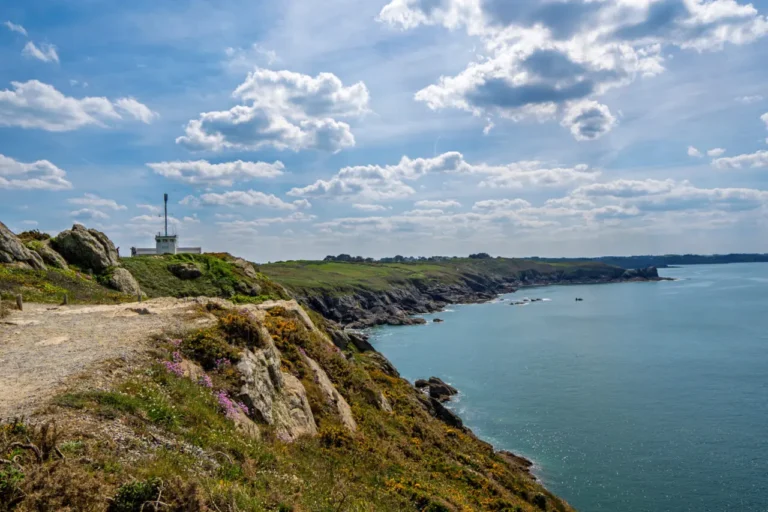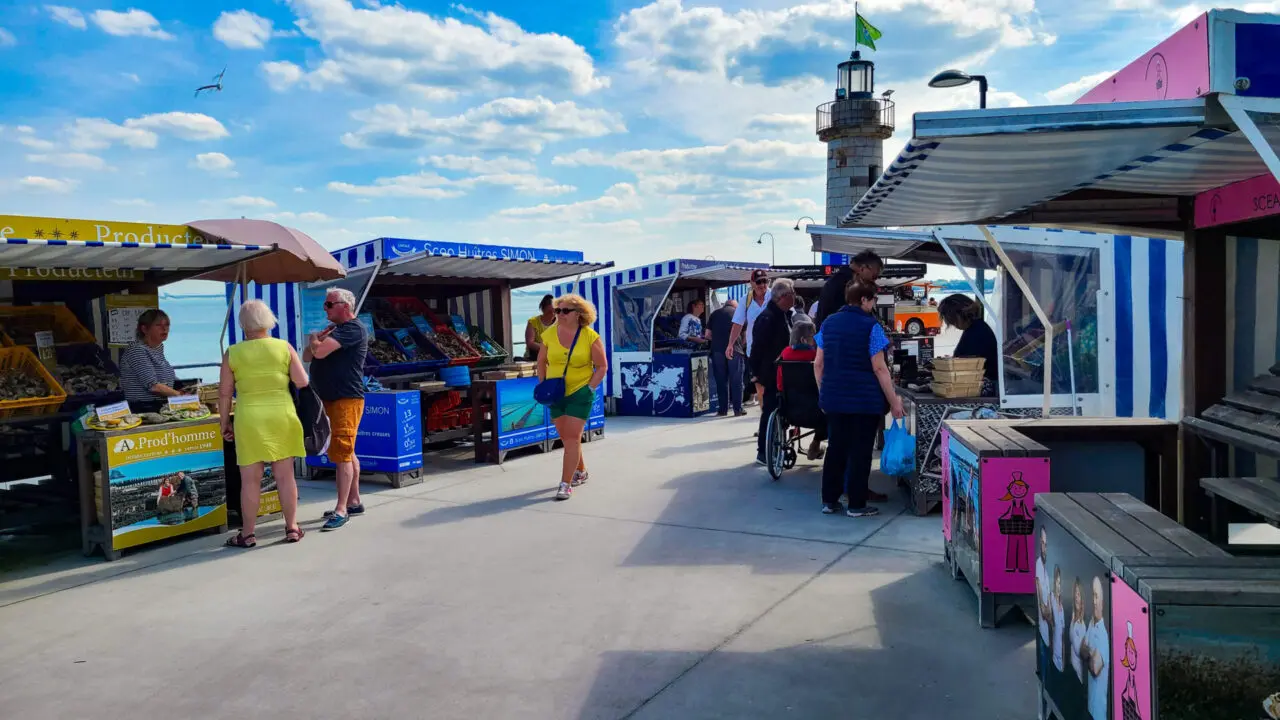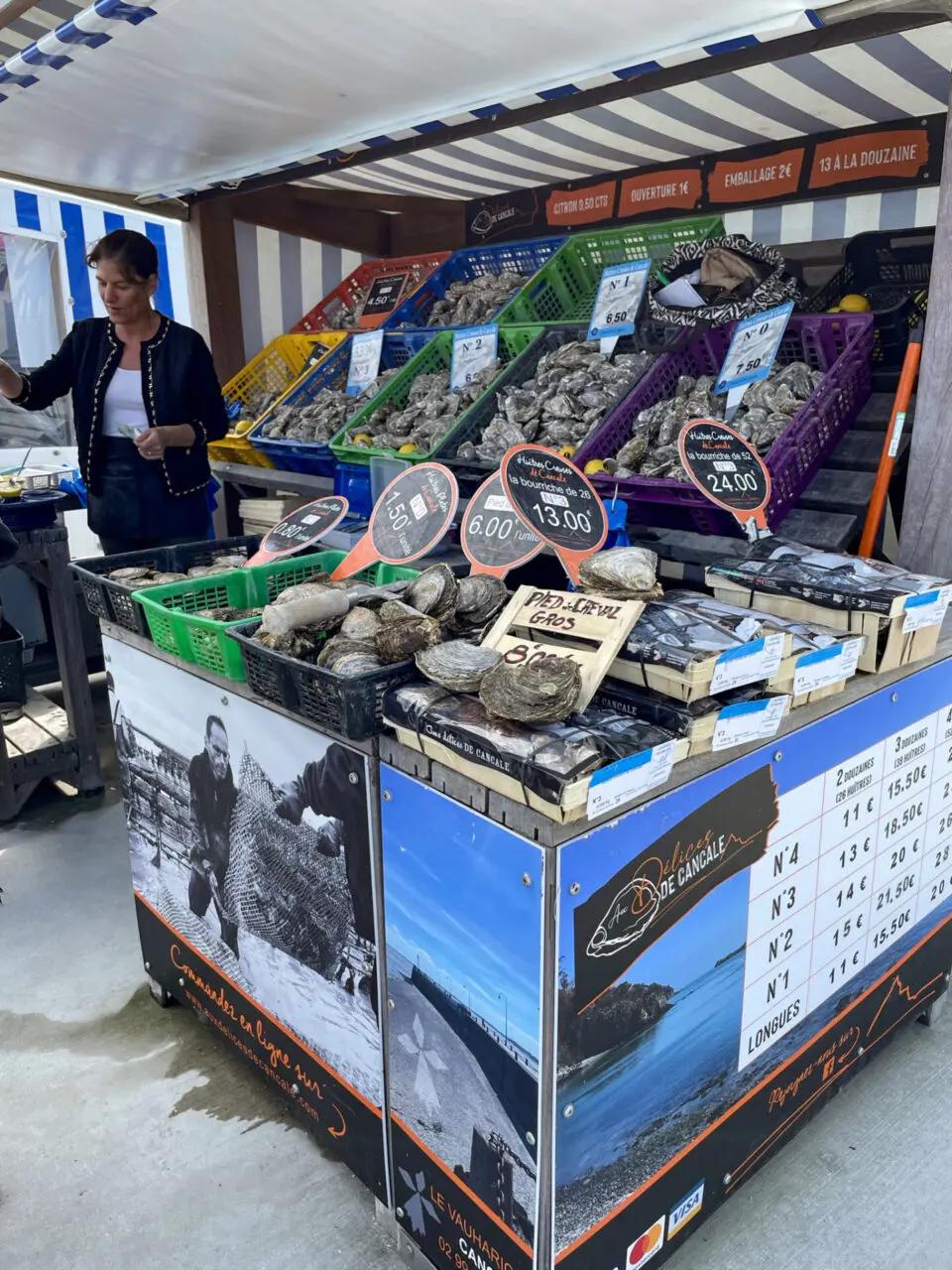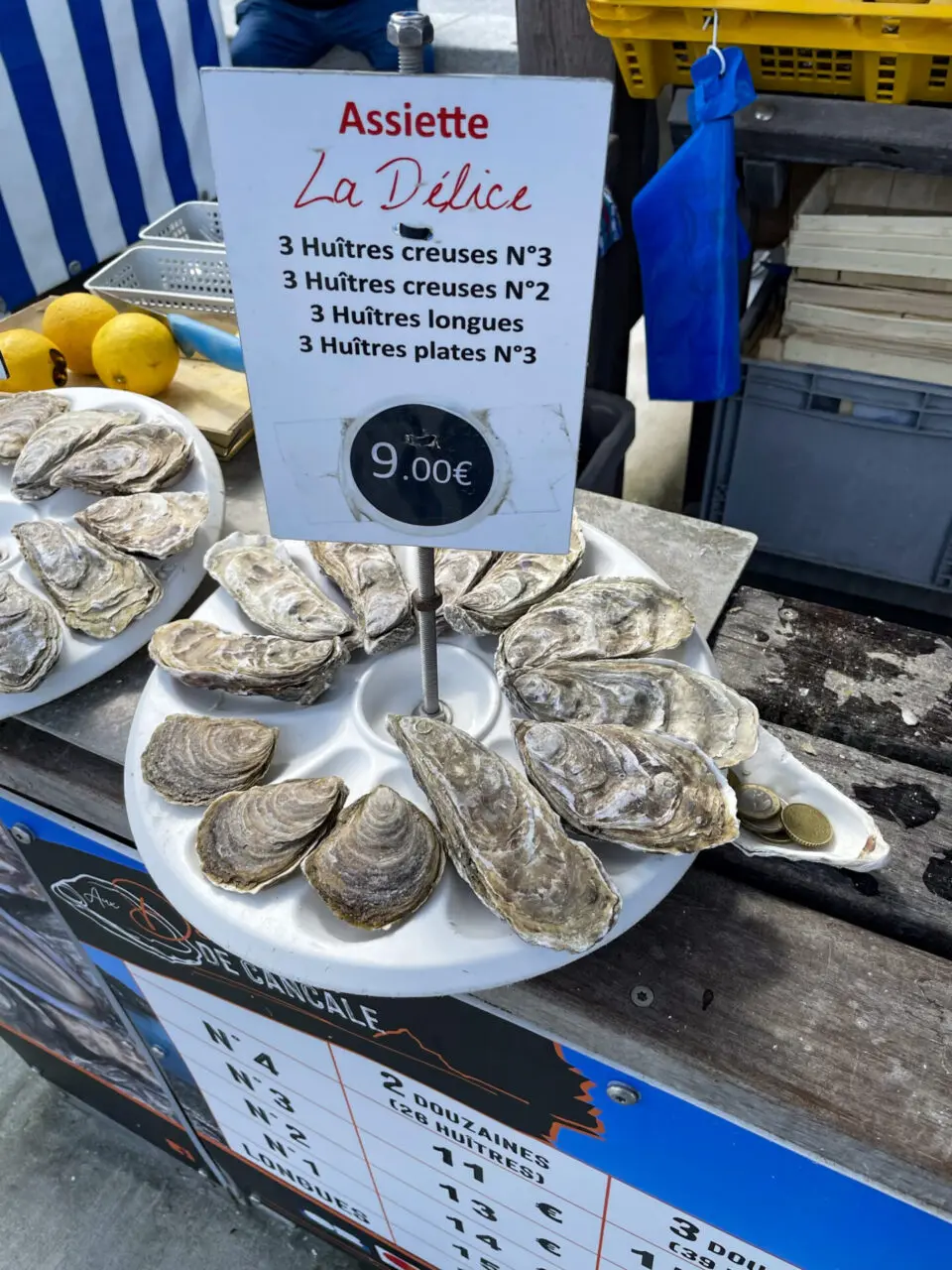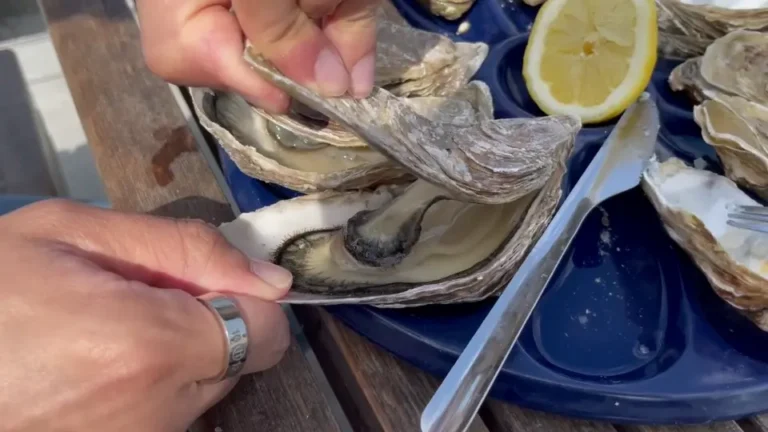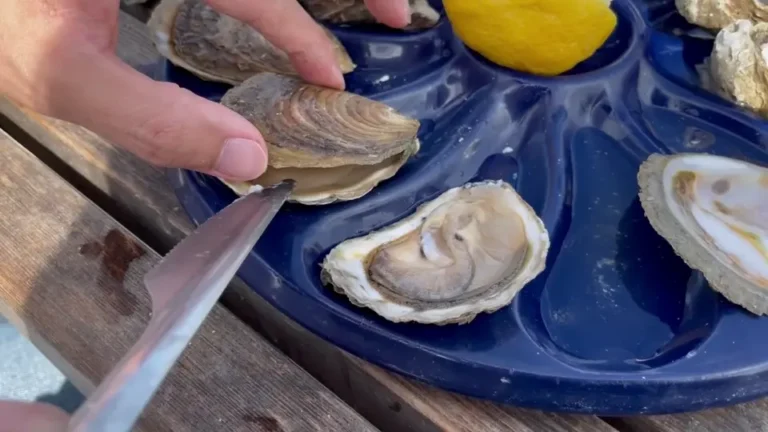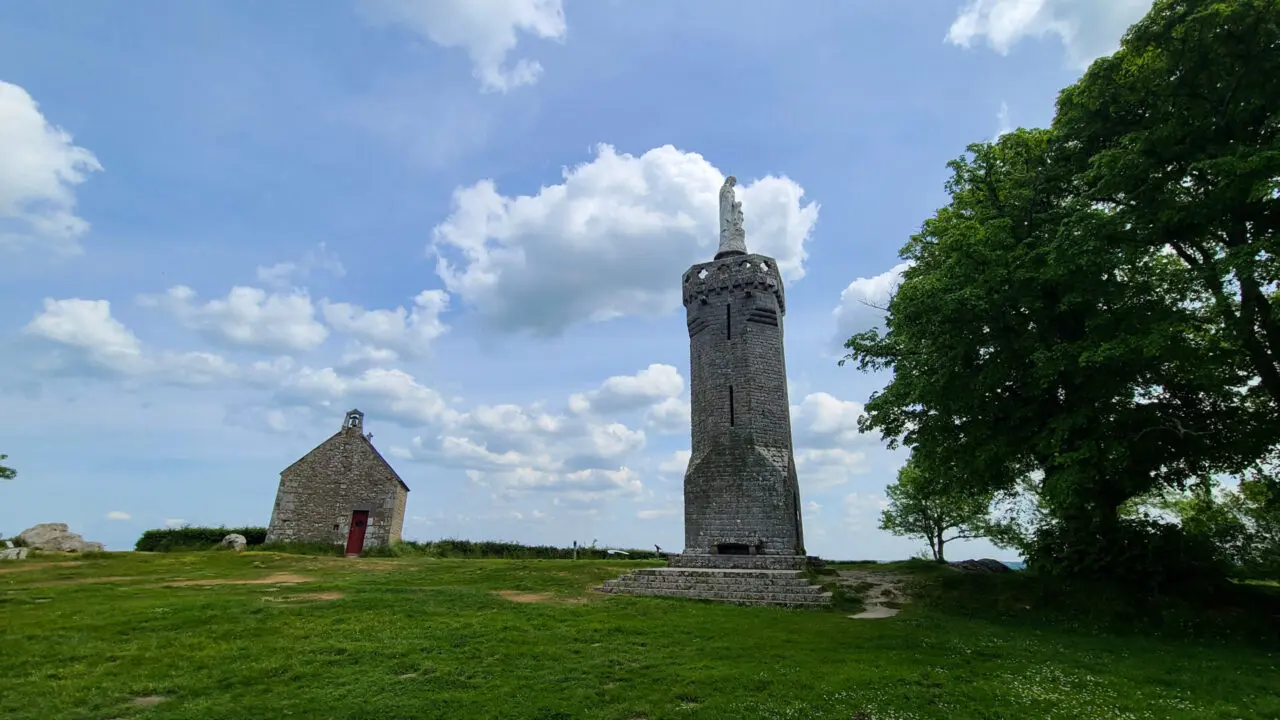There’s a small coastal town called Cancale nestled along the Brittany coast. While it could be pronounced “Can-cal” in English or “Can-call” in French, I’ll stick with “Cancale” for consistency. Like the towns of Lannion and Perros-Guirec I’ve written about before, Cancale sits in the beautiful Brittany region, though it’s quite a distance from those two. So how did we end up in this relatively unknown destination? We were on a 2-night, 3-day trip to see Mont-Saint-Michel and Saint-Malo when we discovered Cancale perfectly positioned between them – the perfect excuse for a spontaneous detour.
In a way, its lesser-known status might be precisely because it’s sandwiched between these famous landmarks. But perhaps that’s exactly its charm – we found a town that felt refreshingly laid-back and peaceful. The coastal cliff paths offered breathtaking views of the open sea and endless horizons, perfect for clearing your mind, while also serving up some of the freshest oysters that Europeans absolutely rave about.
That said, making a dedicated trip just for Cancale might be overkill. Like us, it’s best visited when you’re already exploring the area or passing through – a few hours is just enough to capture its essence.
1. Pointe du Grouin: Dramatic Coastal Cliffs
The GR34 hiking trail that begins at Mont-Saint-Michel, as I mentioned in previous posts, follows the entire Brittany coastline. This means all of Cancale’s shoreline, being part of Brittany and directly adjacent to Mont-Saint-Michel, is included in this famous coastal trail. Thanks to this, the paths are well-maintained and attract plenty of hikers. The most celebrated spot along this stretch is Pointe du Grouin – a famous headland whose very name includes the word “point.”
In French, “Pointe” means headland – land that juts out into the sea. “Grouin” refers to a pig’s snout or a rocky protrusion. So Pointe du Grouin literally translates to “the rocky headland.” This spot offers one of the most renowned viewpoints overlooking Mont-Saint-Michel Bay.
This panoramic shot is a bit distorted, but you can see the protruding headland on the right where most visitors gather. Rather than intimidating sheer cliffs, the terrain feels more like gently rolling hills with occasional steep sections – never feeling particularly dangerous. Still, since everything is solid rock, unless you’re looking to test your body’s durability, it’s wise to walk carefully. The rocks aren’t always flat, so if you’re wearing regular sneakers instead of hiking boots, you’re just asking for a twisted ankle.
From the rocky peak at the center of Pointe du Grouin, looking right reveals Île des Landes – an elongated island. This uninhabited island serves as a marine bird sanctuary, home to cormorants, gulls, shearwaters, and various other seabirds. It’s apparently quite famous among birdwatching enthusiasts.
The emerald waters between this small island and Pointe du Grouin look deceptively calm – almost swimmable. But as you approach the island, the waters become rougher and the rocky terrain more treacherous, making it a perfect one-way ticket to meet Neptune himself.
The second photo captures the coastline to the left. It reminds me somewhat of Jeju Island, yet feels distinctly foreign at the same time. The GR34 trail continues along this entire coastline. While the seaside brings strong winds, Brittany’s climate remains mild even in winter, making it perfect for walking year-round.
2. Cancale's Holy Grail: Marché aux Huîtres
While all of Brittany is famous for seafood, Cancale is particularly renowned for its oysters. Among French food lovers, it’s known as the “Capital of Oysters” (Capitale de l’Huître).
Why are the oysters here so special? First, it’s all about the tides. Mont-Saint-Michel Bay, where Cancale is located, has some of the world’s most dramatic tidal ranges. These strong currents create nutrient-rich waters, allowing oysters to absorb abundant natural plankton, which enhances their flavor and depth.
Second, oyster farming has been practiced here since ancient Roman times – over 2,000 years ago. In 1545, French King François I even designated Cancale oysters as the official “royal oysters.”
So where do you go to taste these famous oysters?
Head to the Marché aux Huîtres de Cancale, which I’ve already spoiled in the subtitle. While you could certainly enjoy a formal meal with various seafood at nearby upscale restaurants, to truly experience Cancale’s unique atmosphere, these colorful local stalls are perfect. The vibrant, festive atmosphere is delightful, and with fixed pricing, you won’t get overcharged like you might in Korea.
Like Chanel perfume, they have numbers from N°4 down to N°1. Since N°1 is the most expensive, I’m guessing it’s the largest size.
Compared to Korean oysters, the prices are quite high. There’s plenty of content comparing Korean and international oysters, so many people probably know this, but the price difference comes down to environment and farming methods. This also translates to differences in taste, size, and flavor. Let me briefly explain.
Regarding species: Korea only farms Crassostrea gigas (Pacific oysters), while Cancale farms both the same Crassostrea gigas (called Huîtres creuses here) and European native oysters called Ostrea edulis (European flat oysters, or Huîtres plates) that you won’t find in Korea.
Environmentally, Korea’s southern seas are relatively calm, while Cancale, as mentioned, has some of the world’s most extreme tidal ranges in rough waters. This makes Cancale oysters firmer, chewier, and more flavorful. Conversely, Korean oysters from the calmer southern and western seas are softer and more tender.
Farming methods also differ. Korean oysters are grown using suspension culture, hanging in the water for 1-2 years before harvest. Cancale oysters grow naturally on the seabed for 3-4 years before being collected. This slower growth gives Cancale oysters their firm texture and deep flavor, while Korean oysters remain softer due to their faster growth cycle.
This is what we ordered – a mixed platter:
- 3 Huîtres creuses N°3 (deep, cupped oysters, size 3)
- 3 Huîtres creuses N°2 (deep, cupped oysters, size 2)
- 3 Huîtres longues (long oysters)
- 3 Huîtres plates N°3 (flat oysters, size 3)
They provide half a lemon with a fork stuck in it, plus a knife for easy shucking. You need to return the plate, fork, and knife to the stall after eating.
They come pre-shucked, so opening them isn’t difficult. Just lift the top shell, scrape with the knife, add a squeeze of lemon, and eat with the fork.
First, the Huîtres creuses – these are Pacific oysters, the same species as Korean oysters but different in size. Even though I’m not particularly fond of raw oysters, the intense ocean flavor and firm texture were satisfying.
Next, the Huîtres plates – the European native oysters. The vendor warned us they’d have a distinctive flavor, and indeed, they had wonderful umami with subtle nutty notes. Is it incredibly special? Not exactly. As a Korean – citizens of a country that ranks overwhelmingly first in global seafood consumption – I’ve probably been trained by countless shellfish experiences.
You just toss the empty shells under the table. Mountains of shells from countless previous visitors pile up like small hills. There’s a bit of a fishy smell, but it’s tolerable. They probably clear them out regularly, otherwise it would be much worse.
3. Mont-Dol: If Cancale Alone Feels Too Quiet
If you head inland from the oyster stalls along the coast, you’ll find some food truck-style vendors, but there isn’t much else to see. While touring the oyster farms is interesting, Korea has plenty of aquaculture too. Walking around ports like Port de Cancale or Port de Pêche has its charm, but you’ll see most of it just walking from the parking lot to the oyster market.
After finishing everything and heading back to our accommodation, we had some extra time and found a nearby spot worth visiting: Mont-Dol. At its center, there’s a hill offering 360-degree panoramic views. Head to Chapelle Notre Dame de l’Espérance – that’s your target destination.
Fortunately, you can drive up the high hill. Park in the shade and the first thing to greet you is a traditional windmill. This traditional stone windmill was built for grinding grain and symbolizes Brittany’s agricultural heritage. It’s supposedly open to tourists, but we didn’t realize the door was unlocked.
Walking past the windmill and further up the hill, you’ll see a small chapel called Chapelle Notre Dame de l’Espérance (Chapel of Our Lady of Hope). As the name suggests, it’s dedicated to the Virgin Mary and is apparently a popular pilgrimage site.
There’s even a legend here – this is supposedly where Saint Michael battled the devil. Saint Michael won, and the devil was banished…
The Notre Dame tower is also open for climbing, though we didn’t realize this either… From the top, you get 360-degree panoramic views with Cancale Bay on one side and Mont-Saint-Michel on the other. I hope someone else will go see it on my behalf.
4. Closing Thoughts
Travel often delivers the deepest emotions in unexpected small places. Isn’t that exactly what makes travel magical? In that sense, Cancale was a gift to us. What seemed like just a small town squeezed between Mont-Saint-Michel and Saint-Malo quickly became a special memory.
Chasing only grandeur leaves you tired and bored. You need experiences that find beauty in simplicity mixed in – that’s what allows you to feel greater joy when you do encounter the spectacular. The quiet towns and humble landscapes nestled between dazzling attractions add depth and flavor to any journey.
This little neighborhood visit to Cancale – I absolutely loved it.



